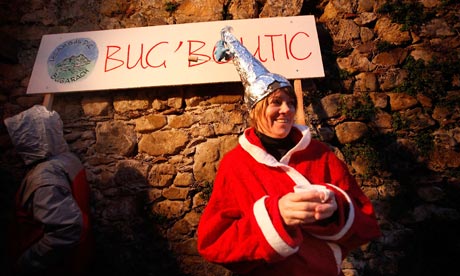
People gather at dusk in Bugarath, where visitors are under the impression that the French village will be spared the coming so-called apocalypse. Photograph: Patrick Aventurier/Getty Images
The dawn of the Mayan apocalypse, when the end of the world is to descend upon us, supposedly according to ancient Latin American texts, is mere hours away.
One group of people is converging on sites such as the remote village of Bugarach on the French side of the Pyrenees or in the picturesque Turkish village of Sirince facing the Aegean Sea. Those flocking to Bugarach seem to be under the impression that while the rest of the world would wither away on December 21, a comet or spaceship would appear in the village to transport them to safer planets or destinations. Likewise, people driven to Sirince are under the conviction that the positive energy of the place would rescue them from the upcoming apocalypse.
Still another group of people is converging on Yucatan itself – the very heartland of the Mayan civilization – either to experience the very convulsion first hand or to be the beneficiary of the positive force that it might unleash in its wake depending on which point of view one subscribes to.
But is all this hysteria about a doomsday borne out by facts? What do Mayans themselves think of it?
My wife and I just came back from a week-long culture trip in early December to Yucatan and Campeche provinces in Mexico. Using Merida as base, we explored a whole swath of Mayan centers from nearby Izamal to far off Edzna in Campeche. In between, we also got a flavor of the daily life of modern Mayans in small outlying towns such as Uayamon or Celestun.
Throughout our trip, we encountered many ordinary Mayans from every walk of life to check out their reaction to the supposedly doomsday prediction. Most of the Mayans we spoke to were largely baffled by the question; others flatly denied that there was any reason that the world would come to an end. Told that a lot of conventional wisdom behind the doomsday scenario in the rest of the world supposedly derived from ancient Mayan texts, they politely replied that they were not aware of any such prediction or text.
In every place we visited, whether in a large city like Merida or a smaller town like Celestun or Uayamon, we found the local people going about their business in perfect calmness without any concern for any impending apocalypse.
Perhaps that was because no such apocalypse is foretold. David Stuart, a noted Mayan and Meso-American specialist at the University of Texas at Austin, observed in his book The Order Of Days: The Maya World and the Truth About 2012, that "no Maya text – ancient, colonial or modern – ever predicted the end of time or the end of the world."
Both Stuart and another noted Mayan scholar, Carl Callaway of La Trobe University in Melborne, Australia, admit that December 21, 2013, marks a special occasion in the ancient Mayan calendar. They hold that December 21, 2012, marks the end of the 13th Bak'tun period. The close of each Bak'tun period occurs approximately once every 5125 years. The last time a Bak'tun period ended was at the beginning of the current Maya era in August 11, 3114 B.C. making December 21, 2013, the dawn of a new period.
"There can be little doubt the ancient Maya would have seen the date as a numerological echo of the current era's start date, and they would have marked the occasion of the 13th Bak'tun with great solemnity and fanfare," writes Callaway in a magazine article titled Ancient Endings and New Beginnings: Maya Cosmology, Just in Time for 2012.
But both scholars admit that only a single Maya text, known as Tortuguero Monument 6, discovered in Tabasco, Mexico, refers to December 21, 2012, as the end of the Bak'tun thirteen. In the entire body of literature of the classical Maya period (250AD-900AD) no other text refers to December 21, 2012, as a significant turning point, they add.
Be that as it may, what is most important is that neither the Tortuguero monument nor any other Mayan text remotely refers to any apocalypse or scenario associated with the end of the world.
The doomsday scenario is simply a human concoction that has nothing to do with what Mayans believed in or predicted. If anything, it would seem, that the image of the apocalypse in the name of the Mayans is a convenient scapegoat to project a large section of our own society's subconscious fears, insecurities and fantasies.
Perhaps the story started with Nibiru, a planet supposedly discovered by the Sumerians, that has been racing towards the Earth and will end up causing the eclipse of the world. Linking the timing of this crash with the December 21 end of an epoch in the Mayan calendar has provided a handy argument, however weak or baseless it might be.
Of course die-hard believers of the doomsday scenario would have none of these rational discussions and would continue to converge on Bugrarach and Sirince. Of late, responding to the complaints of local residents, the French authorities have adopted measures to restrict visits of outsiders to Bugarach, BBC news reported. Meanwhile, good luck if you are thinking of or planning to visit Yucatan now or in the near future. I learned during our recent trip to Merida that hotels in the Yucatan capital have a 100% occupancy rate between now and the end of January 2013.
One group of people is converging on sites such as the remote village of Bugarach on the French side of the Pyrenees or in the picturesque Turkish village of Sirince facing the Aegean Sea. Those flocking to Bugarach seem to be under the impression that while the rest of the world would wither away on December 21, a comet or spaceship would appear in the village to transport them to safer planets or destinations. Likewise, people driven to Sirince are under the conviction that the positive energy of the place would rescue them from the upcoming apocalypse.
Still another group of people is converging on Yucatan itself – the very heartland of the Mayan civilization – either to experience the very convulsion first hand or to be the beneficiary of the positive force that it might unleash in its wake depending on which point of view one subscribes to.
But is all this hysteria about a doomsday borne out by facts? What do Mayans themselves think of it?
My wife and I just came back from a week-long culture trip in early December to Yucatan and Campeche provinces in Mexico. Using Merida as base, we explored a whole swath of Mayan centers from nearby Izamal to far off Edzna in Campeche. In between, we also got a flavor of the daily life of modern Mayans in small outlying towns such as Uayamon or Celestun.
Throughout our trip, we encountered many ordinary Mayans from every walk of life to check out their reaction to the supposedly doomsday prediction. Most of the Mayans we spoke to were largely baffled by the question; others flatly denied that there was any reason that the world would come to an end. Told that a lot of conventional wisdom behind the doomsday scenario in the rest of the world supposedly derived from ancient Mayan texts, they politely replied that they were not aware of any such prediction or text.
In every place we visited, whether in a large city like Merida or a smaller town like Celestun or Uayamon, we found the local people going about their business in perfect calmness without any concern for any impending apocalypse.
Perhaps that was because no such apocalypse is foretold. David Stuart, a noted Mayan and Meso-American specialist at the University of Texas at Austin, observed in his book The Order Of Days: The Maya World and the Truth About 2012, that "no Maya text – ancient, colonial or modern – ever predicted the end of time or the end of the world."
Both Stuart and another noted Mayan scholar, Carl Callaway of La Trobe University in Melborne, Australia, admit that December 21, 2013, marks a special occasion in the ancient Mayan calendar. They hold that December 21, 2012, marks the end of the 13th Bak'tun period. The close of each Bak'tun period occurs approximately once every 5125 years. The last time a Bak'tun period ended was at the beginning of the current Maya era in August 11, 3114 B.C. making December 21, 2013, the dawn of a new period.
"There can be little doubt the ancient Maya would have seen the date as a numerological echo of the current era's start date, and they would have marked the occasion of the 13th Bak'tun with great solemnity and fanfare," writes Callaway in a magazine article titled Ancient Endings and New Beginnings: Maya Cosmology, Just in Time for 2012.
But both scholars admit that only a single Maya text, known as Tortuguero Monument 6, discovered in Tabasco, Mexico, refers to December 21, 2012, as the end of the Bak'tun thirteen. In the entire body of literature of the classical Maya period (250AD-900AD) no other text refers to December 21, 2012, as a significant turning point, they add.
Be that as it may, what is most important is that neither the Tortuguero monument nor any other Mayan text remotely refers to any apocalypse or scenario associated with the end of the world.
The doomsday scenario is simply a human concoction that has nothing to do with what Mayans believed in or predicted. If anything, it would seem, that the image of the apocalypse in the name of the Mayans is a convenient scapegoat to project a large section of our own society's subconscious fears, insecurities and fantasies.
Perhaps the story started with Nibiru, a planet supposedly discovered by the Sumerians, that has been racing towards the Earth and will end up causing the eclipse of the world. Linking the timing of this crash with the December 21 end of an epoch in the Mayan calendar has provided a handy argument, however weak or baseless it might be.
Of course die-hard believers of the doomsday scenario would have none of these rational discussions and would continue to converge on Bugrarach and Sirince. Of late, responding to the complaints of local residents, the French authorities have adopted measures to restrict visits of outsiders to Bugarach, BBC news reported. Meanwhile, good luck if you are thinking of or planning to visit Yucatan now or in the near future. I learned during our recent trip to Merida that hotels in the Yucatan capital have a 100% occupancy rate between now and the end of January 2013.












No comments:
Post a Comment